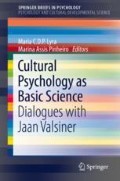Abstract
The meaning construction of “A” implies also the construction of a “non-A.” The tension A <-> non-A represents the process by which meanings acquire possible levels of stability. In this sense, Valsiner (in this volume) argues that how it is possible to arrive in abstractive concepts in science analyzing how people construct new meanings from concrete actions. According to this approach, culture becomes a meta-concept in human science giving space for various theoretical perspectives that are at the level of abstraction of other basic sciences. In Chemistry, many theoretical models were proposed to understand matter and its behavior. This process, through history, can be understood by the model A <-> non-A tension discussed by Valsiner in the Cultural Psychology of Dynamic Semiosis (CPDS) field. Thus, the production of scientific model can be explained by the dynamic of meaning-making in a sociogenetic level, in which opposite meanings emerge and coexist in tension. To illustrate this idea, we intent to provide support to understanding and modeling human semiosis aiming to comprehend how the scientific concept of chemical element acquires an abstract level in tension with concrete views in some periods of history of science.
Access this chapter
Tax calculation will be finalised at checkout
Purchases are for personal use only
References
Aristotle. (1995). The complete works of Aristotle. The revised Oxford translation (Ed. by J. Barnes). Princeton, NJ: Princeton University Press.
Atkins, P. W., & de Paula, J. (2006). Atkins’ Physical chemistry. Oxford: Oxford University Press.
Bachelard, G. (1975). La philosophie du non. Paris: Presses Universitaires de France.
Habashi, F. (2000). Zoroaster and the theory of four elements. Bulletin for the History of Chemistry, 25, 109–115.
Kinsgley, P. (1994). Empedocles and his interpreters: The four-elements doxography. Phronesis, 39(03), 235–254.
Kuhn, T. S. (1970). The structure of scientific revolutions (2nd ed.). Chicago: University of Chicago Press.
Lavoisier, A. L. (1789). Traité Élémentaire De Chimie, 1789. Available in: http://www.labirintoermetico.com/01Alchimia/Lavoisier_A_L_de_Traite_eleme ntaire_de_chimie(1789).pdf. Accessed 07/06/2018.
Mortimer, E. F., & El-Hani, C. N. A. (2014). Theory of teaching and learning scientific concepts, Contemporary trends and issues in science education (Vol. 42, XVII, p. 330). Hollanda: Springer.
Partington, J. R. (1989). A short history of chemistry (3rd ed.p. 415). New York: Dover Publications.
Popper, K. (1959). The logic of scientific discovery. London: Hutchinson.
Silva, J. R. R. T., & Silva, N. M. (2017). Identificação de Compromissos Epistemológicos no Desenvolvimento Histórico do Conceito de Elemento. Revista Debates em Ensino de Química, 3, 93–118.
Valsiner, J. (1998). The Guided Mind. Cambridge, MA: Harvard University Press.
Valsiner, J. (2007). Culture in minds and societies. New Delhi, India: Foundations of Cultural Psychology, Sage Publications India Pvt. Ltd.
Valsiner, J. (2013). Creating sign hierarchies: Social representation in its dynamic context. Papers on Social Representations, 22(2), 16.1–16.32.
Wertsch, J. V. (1985). Vygotsky and the social formation of mind. Cambridge, MA: Harvard University Press.
Zittoun, T., & Cerchia, F. (2013). Imagination as expansion of experience. IPBS: Integrative Psychological & Behavioral Science, 47, 305–324.
Author information
Authors and Affiliations
Editor information
Editors and Affiliations
Rights and permissions
Copyright information
© 2018 The Editor(s) and The Author(s), under exclusive license to Springer Nature Switzerland AG
About this chapter
Cite this chapter
da Silva, J.R.R.T., Macêdo, G.F. (2018). The Tension A <-> non-A in the Meaning-Making of a Chemical Element in a Sociogenetic Level. In: Lyra, M., Pinheiro, M. (eds) Cultural Psychology as Basic Science. SpringerBriefs in Psychology(). Springer, Cham. https://doi.org/10.1007/978-3-030-01467-4_3
Download citation
DOI: https://doi.org/10.1007/978-3-030-01467-4_3
Published:
Publisher Name: Springer, Cham
Print ISBN: 978-3-030-01466-7
Online ISBN: 978-3-030-01467-4
eBook Packages: Behavioral Science and PsychologyBehavioral Science and Psychology (R0)

